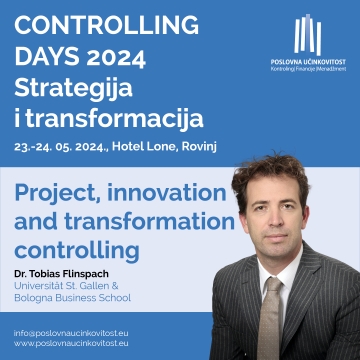Project, innovation and transformation controlling

Dr. Tobias Flinspach, Universität St. Gallen & Bologna Business School, in a short interview explained how the differences between traditional controlling practices and project, innovation, and transformation controlling impact organizational effectiveness and this topic will be discussed in more detail at: CONTROLLING DAYS 2024, Strategija i transformacija, 23.-24.05.2024.
How does project, innovation, and transformation controlling differ from traditional controlling practices within organizations?
Traditional controlling heavily depend on a command and control paradigm. This results often in top down budget where performance is purely measured against a fix target/budget. Modern appproaches enable decentral empowerment for fast and proactive measures.
What are the key metrics and indicators used to measure the success of project, innovation, and transformation initiatives, and how are they integrated into controlling frameworks?
Metrics do not necessarily change but the way they are used. For instance is a IRR (Internal Rate of Return) still a valid metric to measure value creation or a ROCE. Instead of a measuring of target achievement, progress principle gets more important. Rolling Action planning becomes more important where Key Results are continuesly revised instead of fixed KPIs.
How can organizations effectively allocate resources and prioritize investments in projects and innovation initiatives while maintaining alignment with overall strategic goals?
Resource allocation has to reflect strategic directions. Capital budeting can be done by allocating budgets to strategic topics. During the year investment comittees decide on budegt approvals for new projects within the strategic topics instead of allocating capital budgets once a year to organizational units.
What role does risk management play in project, innovation, and transformation controlling, and how can organizations mitigate potential risks while fostering a culture of innovation?
„Trust is good, control is better“ maybe we have to rephrase: If your internal control system is good, trust is better. Decentralicing decision making is key for fast decision making. Therfore, we need good internal control systems to take calculated risks and learn from failures.
How do project, innovation, and transformation controlling practices contribute to organizational agility and adaptability in rapidly changing market environments?
Traditional controlling practices can be a show stopper for organizational agility. Changing controlling practices is a fundamental enabler for organizational agility.
You can learn more about how traditional controlling methods, based on a command and control structure, contrast with modern approaches at: CONTROLLING DAYS 2024, Strategija i transformacija, 23.-24.05.2024.
Novosti

